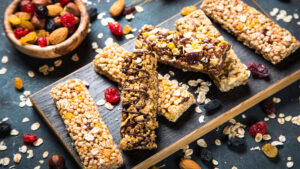Quality packaging is an essential part of snack bar production, ensuring that the product is protected during shipping and storage, and that it arrives in good condition to the consumer. The packaging also plays a critical role in attracting buyers, with eye-catching designs and clear labeling that communicates the product’s features and benefits. In recent years, there has been a growing demand for sustainable packaging solutions, with consumers increasingly concerned about the environmental impact of their purchases.
Snack bar manufacturers are responding to this demand by exploring new materials and designs that minimize waste and reduce their carbon footprint. One example is the recent launch of Nestlé’s YES! snack bars in a new recyclable paper wrapper. This breakthrough innovation marks the first time that a confectionery bar has been packaged in paper using a high-speed flow wrap technology. The paper wrapper is coated with a water-based coating to ensure freshness and shelf life, and it is fully recyclable, providing a more sustainable alternative to traditional plastic packaging.
Importance of Quality Packaging in Snack Bar Production
The packaging is the final step in snack bar production and plays a crucial role in ensuring the product reaches the consumer in the best possible condition. Quality packaging not only protects the snack bars from damage during transportation but also helps to maintain their freshness and flavour.
When it comes to snack bar production, the packaging must be carefully designed to meet the needs of the product. The packaging should be sturdy and durable enough to protect the bars from damage during shipping and handling. It should also be easy to open and resealable to allow for convenient snacking.
Moreover, the packaging should be visually appealing and informative. It should provide consumers with all the necessary information about the product, including the ingredients, nutritional value, and any allergens. This can be achieved through the use of clear and concise labeling, as well as attractive graphics and designs.
In addition, the packaging should be environmentally friendly. Consumers are increasingly concerned about the impact of packaging on the environment and are more likely to choose products that are packaged in sustainable materials. Snack bar manufacturers can meet this demand by using recyclable or biodegradable materials for their packaging.
Overall, quality packaging is an essential component of snack bar production. It helps to protect the product, maintain its freshness and flavour, and provide consumers with the information they need to make informed purchasing decisions. By investing in quality packaging, snack bar manufacturers can ensure that their products are wrapped for success.
Materials Selection for Snack Bar Packaging
Snack bar packaging plays a critical role in product quality and shelf life. The right packaging can keep the product fresh and safe, while also attracting consumers with its design and functionality. When selecting materials for snack bar packaging, manufacturers must consider several factors, including sustainability, barrier properties, durability, and protection.
Sustainability Considerations
Sustainability is a growing concern for consumers and manufacturers alike. Choosing eco-friendly materials can help snack bar manufacturers reduce their environmental footprint and appeal to consumers who prioritize sustainability. Some eco-friendly packaging materials include biodegradable plastics, recycled paper, and plant-based materials.
Barrier Properties
Snack bar packaging must protect the product from moisture, oxygen, and other external factors that can affect its quality and freshness. The packaging must also prevent the migration of flavours and odors. Choosing materials with the right barrier properties can help manufacturers extend the shelf life of their products and maintain their quality. Some materials with good barrier properties include aluminum foil, metallized films, and certain types of plastics.
Durability and Protection
Snack bar packaging must also be durable enough to withstand the rigors of transportation and storage. The packaging must protect the product from physical damage, such as crushing or puncturing. Choosing materials with good durability and protection can help manufacturers ensure that their products arrive at their destination in good condition. Some materials with good durability and protection include corrugated cardboard, bubble wrap, and certain types of plastics.
In conclusion, selecting the right materials for snack bar packaging is critical to the success of the product. Manufacturers must consider sustainability, barrier properties, durability, and protection when selecting materials. By choosing the right materials, manufacturers can ensure that their products are fresh, safe, and attractive to consumers.
Designing for Success
When it comes to snack bar production, quality packaging is the final step that can make or break the success of a product. A well-designed package not only protects the product but also attracts customers and communicates the brand’s message. Here are some key factors to consider when designing packaging for snack bars.
Visual Appeal
Visual appeal is crucial when it comes to snack bar packaging. The package should catch the customer’s eye and stand out on the shelf. A visually appealing design can be achieved through the use of bold colors, eye-catching graphics, and unique shapes. It’s important to keep in mind that the design should reflect the brand’s values and message.
Brand Consistency
Brand consistency is essential in any product’s packaging. The packaging should reflect the brand’s identity, values, and message. This can be achieved through the use of consistent colors, fonts, and graphics. Consistent branding helps customers recognize the product and builds trust in the brand.
Consumer Convenience
Consumer convenience is another important factor to consider when designing snack bar packaging. The package should be easy to open and resealable to keep the product fresh. It should also be portable and easy to carry, making it a convenient snack for on-the-go customers. Including nutritional information and ingredients on the package can also make it easier for customers to make informed purchasing decisions.
Conclusion: Materials Matter
In conclusion, designing quality packaging for snack bars is an essential step in ensuring the success of a product. By considering factors such as visual appeal, brand consistency, and consumer convenience, brands can create packaging that not only protects the product but also attracts and retains customers.
Quality packaging stands as an indispensable aspect of snack bar production, safeguarding products during shipping and storage while serving as a pivotal tool for consumer attraction with its captivating designs and informative labels. Responding to the rising demand for sustainability, snack bar manufacturers are embracing innovative materials such as Nestlé’s YES! snack bars packaged in recyclable paper wrappers, setting a precedent in eco-friendly alternatives to traditional plastic packaging.
Not only does quality packaging ensure the preservation of snack bar freshness and flavour, but it also empowers consumers with essential product information for informed purchasing decisions. Optimal materials selection, considering sustainability, barrier properties, durability, and protection, aligns with the environmentally conscious consumer preferences, utilizing eco-friendly options like biodegradable plastics and recycled paper while maintaining product quality. Simultaneously, thoughtful packaging design incorporating visual appeal, brand consistency, and consumer convenience, such as easy resealability and portability, amplifies product recognition and trust, ultimately ensuring the success of snack bar products.
Leading image: FotoDuets/Shutterstock.com





